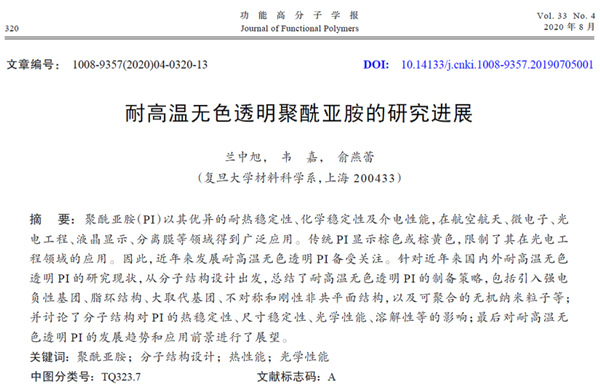Search
Title: Recent Progress in Colorless and Transparent Polyimide with High Thermal Stability
Author: Zhongxu Lan, Jia Wei*, Yanlei Yu*
Journal: Journal of Functional Polymers, 2020, 33(4), 320-332
Abstract:
Polyimides (PIs) have extensive applications in the aerospace industry, microelectronic and optoelectronic engineering, liquid crystal display, and separation membrane due to their high-temperature resistance, outstanding mechanical properties, chemical and radiation resistance, and excellent dielectric properties. Conventional PIs possess strong inter- and intra- molecular charge transfer interactions, resulting in an intense stack of the molecular chains, which leads to strong absorption in the visible region and brings deep color to PIs. This has considerably restricted their applications in the area of optoelectronic and microelectronic engineering. With the rapid development of display technology, PIs with excellent optical and thermal performance are desired to serve as substrate materials. However, achieving a breakthrough in the molecular design of the satisfied PIs remains challenging with regarding to the trade-off between good transparency and thermal stability of PI films. Recently, enormous research efforts have been devoted to the development of colorless and transparent PIs with high thermal stability via rational molecular structure design, as summarized in this review. These fabrication strategies mainly include the introduction of strong electronegative groups, alicyclic structures, bulky pendent units, asymmetric and rigid noncoplanar segments, and polymerizable inorganic nanoparticles. The incorporation of these structures plays an important role in disrupting the conjugation between the PI chains. This disruption reduces the regularity and weakens the stack of the molecular chains, while increasing the free volume of the PI chains, thus prohibiting the formation of inter- and intra- molecular charge transfer complex. All these are beneficial to minimize the absorption in the visible region and the formation of colorless PIs. Then, the influences of molecular structures on the properties of PI, such as thermal properties, optical performance and solubility, are discussed. Finally, the prospect of colorless and transparent PI with high thermal stability is discussed with respect to their development trends and potential applications.
Fulltext Link: https://gngfzxb.ecust.edu.cn/en/article/doi/10.14133/j.cnki.1008-9357.20190705001








